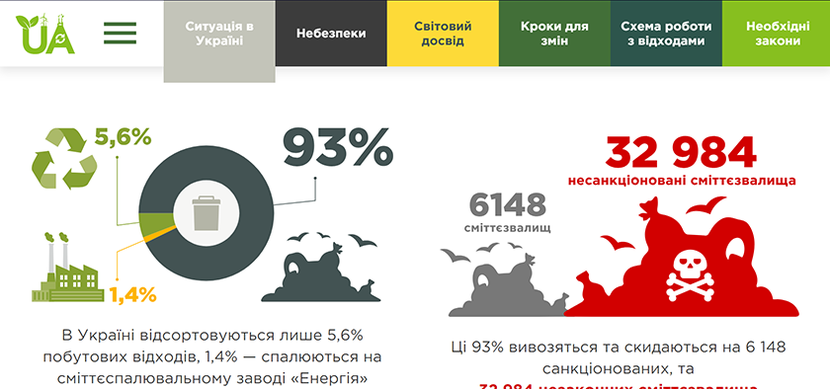Study on Waste Management in Ukraine
The situation in Ukraine regarding waste management has already proven to be critical in many cities and regions due to a lack of proper waste management infrastructure and adequate government policy, business approach and public response. In 2014–2017, Ukraine took initial important steps through commitment of compliance with the EU Directives as a part of the Association Agreement and adopting the National Waste Management Strategy until 2030. The aim of this study is to identify opportunities and niches for Dutch companies on the national and regional levels in the Ukrainian waste management sector.

The complete study can be found in this link https://www.rvo.nl/sites/default/files/2019/02/Waste-management-in-Ukraine.pdf
For more information you can also contact the economic department of the embassy of the Netherlands in Ukraine via KIE-EA@minbuza.nl
From the executive summary:
The situation in the waste management sector of Ukraine is continuously defined as critical in recent market studies, official documents, reports and analytics by NGOs / CSOs in terms of the status and trends in waste generation, accumulation, storage, processing, recycling and disposal. The situation has already proven to be emergent in many cities and regions and in many waste subsectors due to the lack of proper waste management infrastructure and adequate government policy, a business approach and public response.
The issue of waste management in Ukraine is particularly significant because of the traditional dominance of resource-intensive and non-waste-use technologies in the national economy. Waste generated in the process of extraction, enrichment, chemical-metallurgical processing, transportation and storage of minerals is a secondary raw material reserve for the industrial, construction and energy sectors. Secondary raw materials from remnants of final consumption products
(e.g. waste paper, polymers, glass, worn tires, etc.) also have considerable resource potential. Low tariffs on waste disposal services do not create incentives for businesses and local authorities to recycle waste.
Significant volumes of accumulated waste, absence of relevant infrastructure and lack of effective measures to prevent waste generation and introduce the integrated waste management approach deepen the ecological crisis and become a restraining factor in development of the Ukrainian national, regional and local economies.
Considering the context of the integrated MSW management concept, Ukraine is currently positioned at the lowest level of the waste hierarchy with the absent or limited preventing framework, prevailing mix waste collection in preparation for use, recycling in a limited scope, other recovery steps implemented just initially and disposal to landfills as the main waste management technique. New technologies’ introduction is limited by the lack of integrated management decisions and by insufficient financial resources and economic incentives. A small number of innovative technologies, if any, are adopted.
According to the Ukrstat data, over 295.9 million tons of waste was generated in Ukraine in 2016, including 289.5 million tons (97.8%) of waste generated by the industry and 6.4 million tons (2.2%) of waste generated by households. At this, 218 million tons (almost 74% of the generated waste) was generated by the mining and quarrying industry. Only households and the power-, gas- and heat- supply sector demonstrated growth in waste generation; with the agricultural and construction indicators almost at the same level as in 2015.
The situation with municipal solid waste management in Ukraine is still at a very basic level, when waste management consists of collection of mixed waste and landfill disposal. According to the Ukrstat data, of 11.6 million tons of MSW and similar waste generated in Ukraine in 2016, only 0.09% was recovered, 3.73% was incinerated and the rest 87.67% was landfilled.
The high level of waste generation and the low rates of its use as a secondary raw material have led to the fact that in Ukraine in the industrial and municipal sector majority of solid waste accumulated each year is disposed of into landfills. According to the official data on 5 487 landfills and dumps in Ukraine, in 2016 almost 6% of them were overloaded and 30% did not meet national environmental safety standards. According to the official data, due to the insufficient level of control and lack of a proper MSW management system, over 27 thousand unauthorized dumps are formed each year.
Despite the fact that the nominal amount of capital and operational expenditures in the whole waste management sector from all sources of financing increased from UAH 1.67 billion (or € 263.49 million) in 2006 to UAH 8.93 billion (or € 315.58 million) in 2016, the MSW sector is greatly underfinanced.
In 2014–2017, Ukraine made initial important steps to change the situation through commitment to comply with the EU Directives as part of the Association Agreement with the EU and adoption of the National Waste Management Strategy until 2030.
The National Waste Management Strategy provides short-, mid- and long-term directions for addressing challenges for all main waste subsectors (industrial waste, construction and demolition waste, hazardous waste, agroindustrial waste and specific waste streams) as well as provides fulfillment of obligations of Ukraine according to the international agreements. The Strategy is developed with the support of international donors and is considered one of the main drivers of the waste management market development, compliant with the EU requirements and close to the innovative integrated concept.
Following the EU countries’ move toward what is referred to as ‘integrated solid waste management (ISWM), the National Waste Strategy 2030 signals going away from sole reliance on landfill disposal with an increased focus on recycling and recovery for certain waste streams while the residual waste is disposed of into EU-compliant landfills. It proposes a significant increase in the coverage of the population with organized MSW separate collection and a progressive movement toward increased levels of recycling and recovery.